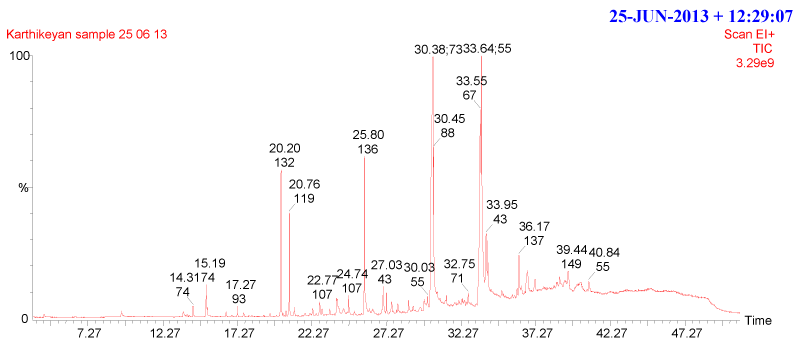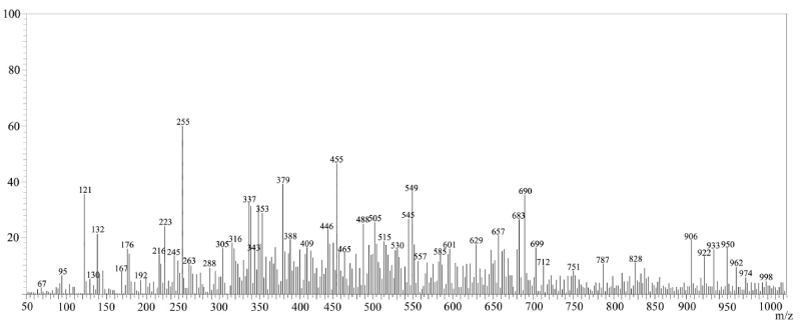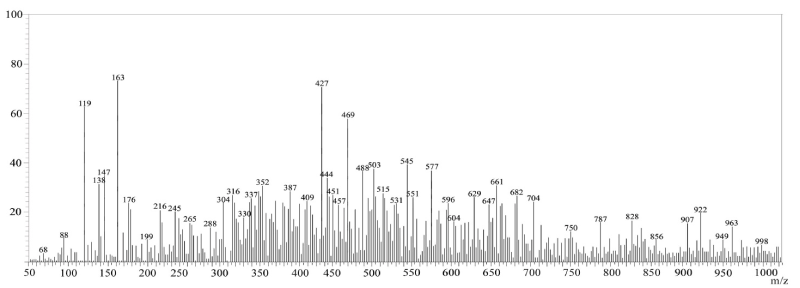Research Article Open Access
Phytochemical Analysis of Cynanchum callialatum through GCMS and LCMS
| Karthikeyan M1* and Balasubramanian T2 | |
| 1Research Scholar, Department of Pharmacy and Medical Sciences, Singhania University, Rajsathan, India | |
| 2Associate Professor, Department of Pharmacology, Alshifa College of Pharmacy, Kerala, India | |
| Corresponding Author : | Karthikeyan M Research Scholar, Department of Pharmacy and Medical Sciences Department of Pharmacy School of Pharmacy and Medical Sciences, Singhania University Pacheribari, Jhunjhunu, 333515-Rajsathan, India Tel: +91 9656111669 E-mail: karthikeyanpgt@gmail.com |
| Received November 21, 2013; Accepted December 26, 2013; Published January 02, 2014 | |
| Citation: Karthikeyan M, Balasubramanian T (2014) Phytochemical Analysis of Cynanchum callialatum through GCMS and LCMS. J Homeop Ayurv Med 3:143. doi: 10.4172/2167-1206.1000143 | |
| Copyright: © 2014 Karthikeyan M, et al. This is an open-access article distributed under the terms of the Creative Commons Attribution License, which permits unrestricted use, distribution, and reproduction in any medium, provided the original author and source are credited. | |
Visit for more related articles at Journal of Traditional Medicine & Clinical Naturopathy
Abstract
Medicinal plants are still important source for drug discovery. Herbal medicines have gained importance in recent years because of their efficacy and cost effectiveness. The objective of the present study is to investigate the phytochemical present in the Cynanchum callialatum. The phytochemical analysis was done by preliminary phytochemical test for secondary metabolites, GCMS for volatile constituents and LCMS for nonvolatile constituents. The phytochemical test confirms the presents of alkaloids, flavonoids, terpenoids, tanins etc. The GCMS analysis shows the presents of 52 compounds in which some have medicinal value. The LCMS analysis shows the presents of compounds in which most of them have the medicinal properties. The present study on Cynanchum callialatum reveals the presence of various phytochemical constituents like Betulinic acid, Lupeol, Germacrone and Longiverbenone. Cynanchum callialatum may be a potential source for anticancer, antiHIV, antiinflammatory, antimicrobial drug discovery.
| Keywords |
| Cynanchum callialatum; Phytochemical analysis; GCMS; LC/MS |
| Introduction |
| Plant still remains a major source for drug discovery in development of synthetic molecules. The use of traditional plant extract in the treatment of various diseases has been flourished. In the early 19th century, when chemical analysis first became available, scientists began to extract and modify the active ingredients from plants. The World Health Organization estimated that about 80% of the world population relays on herbal medicines. |
| Herbal medicines have gained importance in recent years because of their efficacy and cost effectiveness. These drugs are invariable single plant extracts or mixtures of extracts from different plants, which have been carefully standardized for their safety and efficacy. Substances derived from the plants remain the basis for a large proportion of the commercial medications used today for the treatment of heart disease, high blood pressure, pain, asthma and infectious diseases [1]. Nowadays medicinal plants receive more attention to researchers because of their safety and curative property which is due to the complex mixtures secondary metabolites. |
| Cynanchum is a genus of about 300 species including some swallowwort’s, belongs to the milkweed family Asclepiadaceae. Most species are non-succulent, climbers or twiners. These plants are perennial herbs or sub shrubs, often growing from rhizomes. The leaves are usually oppositely arranged and sometimes are borne on petioles. The inflorescences and flowers come in a variety of shapes. These plants bear follicles, which are pod like dry fruits. These species are found worldwide in the tropics and subtropics. Several species also grow in temperate regions. Cynanchum varieties are prescribed in chinese medicine to treat fever, cough, pneumonia and asthma [2]. Cynanchum callialatum twiner to 4 m, latex milky, flowers white, widely distributed in India. Cynanchum callialatum has been used to treat wounds, headaches, infections and other skin related problems by tribes in Tamil Nadu, India. |
| Based on the literature review there is no scientific reports on phytochemical constituents of Cynanchum callialatum. The present study has made an attempt to identify the chemical constituents from the areal parts of Cynanchum callialatum through GCMS and LCMS. |
| Materials and Methods |
| Plant material |
| The plant Cynanchum callialatum was collected from Pollachi, Coimbatore District, Tamil Nadu, India and It has been identified and authenticated by Dr. Udyan P.S., Professor, Sreekrishna College, Guruvayur, Thrissur, Kerala, India. |
| The areal parts of the Cynanchum callialatum were collected during March-April month and washed with water. Then the plant material was shade dried for 10 days. The dried plant materials have been powdered using mechanical grinder to get uniform coarse particles. The powdered plant material was stored in polythene air tight containers at room temperature for further use. |
| Preparation of the crude plant extract |
| The shade dried coarse powdered bark of Cynanchum callialatum (250 g) was packed in the soxhlet extraction apparatus and extracted with 2 L of 95% ethanol at a temperature of 40-50°C for 72 hr. The extract was filtered and the filtered extract was then concentrated to dryness in a rotary evaporator under reduced pressure at temperature of 40°C. The resultant green color residue was stored in a desiccator for use in subsequent experiments and considered as the crude ethanol extract. The yield of the ethanolic extract was 14% w/w. |
| Phytochemical analysis |
| The preliminary phytochemical screening test was carried out in ethanolic extract of Cynanchum callialatum to find out the nature of chemical compounds as per the standard procedures [3-6] and the phytoconstituents were identified through GCMS and LCMS (Tables 1- 3). |
| GCMS specifications |
| Make: PerkinElmer Clarus 500 |
| Software: Turbomass ver 5.2.0 |
| Column Type: Capillary Column Elite-5MS (5%Phenyl 95% dimethylpolysiloxane) |
| Column length: 30 m |
| Column id: 250 μm |
| GC conditions |
| Oven Program: 50°C@6°C/min to 220°C (2 min)@6°C/min to 270°C (10min) |
| Injector temperature: 280°C |
| Carrier gas: Helium @ flow rate 1 ml/min |
| Split ratio: 1:20 |
| MS conditions |
| Mass Range: 40-600 amu |
| Type of Ionization: Electron Ionization (EI) |
| Electron energy: 70 ev |
| Transfer line and source temperature: 200°C, 180°C |
| Library: NIST 2005 |
| Sample injected: 1.0 microlitre |
| LCMS specifications |
| LC column: ReversePhaseC-18PUMP:SPD10AVP |
| Mobile Phase: water: Methanol (50:50) |
| Ionization Mode: Electronic Spray Ionization |
| Mode: Both Positive and negative |
| Injection Volume: 10 microlitre |
| Flow Rate: 2 ml/min |
| Column Temperature: 250°c |
| Column: PhenomenexRP18 |
| Column Dimension: 25 cmx2.5 mm |
| LC Detection: 254 nm |
| M/Z Range: 50-1000 |
| Software: classvp integrated. |
| Library: Metwin2.0 |
| Results and Discussion |
| Cynanchum callialatum twiner to 4 m, latex milky, flowers white widely distributed in India. Cynanchum callialatum has been used to treat wounds, headaches, infections and other skin related problems by tribes in Tamil Nadu, India. As per our knowledge the chemicals constituents of Cynanchum callialatum was not yet scientifically reported. Moreover, identification of chemical constituents in the crude drugs is the basic goal to prove its pharmacological effects behind the folklore uses and ultimate discovery of novel therapeutics. In the present study phytochemical investigation on Cynanchum callialatum ethanolic extract has been done by preliminary phytochemical screening, GCMS and LCMS analysis (Figures 1-3). Our study reveals the presence of various natural bioactive compounds shown in table 1 and 2 and these chemical compounds also been found in other species of Cynanchum [7]. |
| Expected pharmacological properties of Cynanchum callialatum |
| The photochemical investigations on Cynanchum callialatum ethanolic extract have revealed the presence of several natural compounds (Tables 1 and 2) and most of them have various biological activities. |
| Betulinic acid: Betulinic acid, is a naturally occurring pentacycliclupane- type triterpenoid which exhibits a variety of biological and medicinal properties such as inhibition of human immunodeficiency virus (HIV), anti-bacterial, anti-malarial, antiinflammatory, anthelmintic, antinociceptive, anti-HSV-1, anti- HSV-1 , and anti- cancer activities [8]. |
| Lupeol: Lupeol, a phytosterol and triterpene, is widely found in edible fruits, and vegetables. In various in vitro and preclinical animal studies suggest that lupeol has a potential to act as an antiinflammatory, anti-microbial, anti-protozoal, anti-proliferative, antiinvasive, anti-angiogenic and cholesterol lowering agent. Employing various in vitro and in vivo models, lupeol has also been tested for its therapeutic efficiency against conditions including wound healing, diabetes, cardiovascular disease, kidney disease, and arthritis. Lupeol has been found to be pharmacologically effective in treating various diseases under preclinical settings (in animal models) irrespective of varying routes of administration viz; topical, oral, intra-peritoneal and intravenous. It is note worthy that lupeol has been reported to selectively target diseased and unhealthy human cells, while sparing normal and healthy cells. Lupeol modulates the expression or activity of several molecules such as cytokines IL-2, IL4, IL5, ILβ, proteases, α-glucosidase, cFLIP, Bcl-2 and NFκB [9]. |
| Germacrone: Germacrone possessed antiviral activity against the H1N1 and H3N2 influenza A viruses and the influenza B virus in a dose-dependent manner. The viral protein expression, RNA synthesis and the production of infectious progeny viruses were decreased both in MDCK and A549 cells treated with germacrone. In a time-of-addition study, germacrone was found to exhibit an inhibitory effect on both the attachment/entry step and the early stages of the viral replication cycle. Germacrone also exhibited an effective protection of mice from lethal infection and reduced the virus titres in the lung [10]. The germacrone possessed anti-proliferative effect of on the human hepatoma cell lines. Treatment of human hepatoma cell lines HepG2 and Bel7402 with germacrone resulted in cell cycle arrest and apoptosis in a dosedependent manner as measured by MTT assay, flow cytometric and fluorescent microscopy analysis, while much lower effect on normal human liver cell L02 was observed. Germacrone might be a new potent chemo preventive drug candidate for liver cancer via regulating the expression of proteins related to G2/M cell cycle and apoptosis, and p53 and oxidative damage may play important roles in the inhibition of human hepatoma cells growth [11]. |
| Longiverbenone: Is a sesquiterpene isolated which possess antibacterial and cytotoxic activity. The cytotoxic activity (LC50) of the compound longiverbenone new born brine shrimp (Artemiasalina) is presented in (Table 3). The LC50 of the compound against the brine shrimp was found to be 14.38 μg/ml. The cytotoxic bioassay result of longiverbenone may lead to the exploration of its potential and practical application as a novel less toxic and antimicrobial compound from this plant. Similar cytotoxic activities of plant constituents have been reported previously [12]. |
| Sinapic acid (SA): shows cerebral protective and cognitionimproving medicine.SA has anti-oxidative and anti-inflammatory activities, and may be an efficacious treatment for Alzheimer’s disease [13]. |
| Daucosterol: The treatment with DS-given mice with anti-mouse IFNγ, the protection was also abolished. These show that DS protects mice against disseminated candidiasis by the CD4+ Th1 immune response [14]. Daucosterol improved blood circulation by inhibiting ether platelet aggregation and/or blood coagulation [15]. |
| Taraxasterol: Have been shown experimentally to inhibit colon and breast cancer development. They act at various stages of tumor development, including inhibition of tumorigenesis, inhibition of tumor promotion, and induction of cell differentiation. Effectively inhibit invasion of tumor cells and metastasis [16]. Taraxasterol dramatically decreased the total inflammatory cell and reduced the production of Th2 cytokine IL-4, IL-5, IL-13 in BALF and OVAspecific IgE in sera, and suppressed AHR in a dose-dependent manner. Histological studies evidenced that the taraxasterol substantially suppressed OVA-induced inflammatory cells infiltration into lung tissues and goblet cell hyperplasia in airways [17]. |
| Conclusion |
| The present study on phytochemical investigation of Cynanchum callialatum reveals the presence of various phytochemical constituents which support its use in folk medicine. This study also helps us to carry out researches based on the bioactive compounds, and to confirm scientifically the anticancer, antiretroviral, antimalarial, antiinflammatory activities of Cynanchum callialatum. Our study suggests that Cynanchum callialatum may be a potential source for anticancer, antiHI, anti-inflammatory, antimicrobial drug discovery. |
References
|
Tables and Figures at a glance
| Table 1 | Table 2 | Table 3 |
Figures at a glance
 |
 |
 |
| Figure 1 | Figure 2 | Figure 3 |
Relevant Topics
- Acupuncture Therapy
- Advances in Naturopathic Treatment
- African Traditional Medicine
- Australian Traditional Medicine
- Chinese Acupuncture
- Chinese Medicine
- Clinical Naturopathic Medicine
- Clinical Naturopathy
- Herbal Medicines
- Holistic Cancer Treatment
- Holistic health
- Holistic Nutrition
- Homeopathic Medicine
- Homeopathic Remedies
- Japanese Traditional Medicine
- Korean Traditional Medicine
- Natural Remedies
- Naturopathic Medicine
- Naturopathic Practioner Communications
- Naturopathy
- Naturopathy Clinic Management
- Traditional Asian Medicine
- Traditional medicine
- Traditional Plant Medicine
- UK naturopathy
Recommended Journals
Article Tools
Article Usage
- Total views: 14915
- [From(publication date):
February-2014 - Apr 03, 2025] - Breakdown by view type
- HTML page views : 10161
- PDF downloads : 4754
